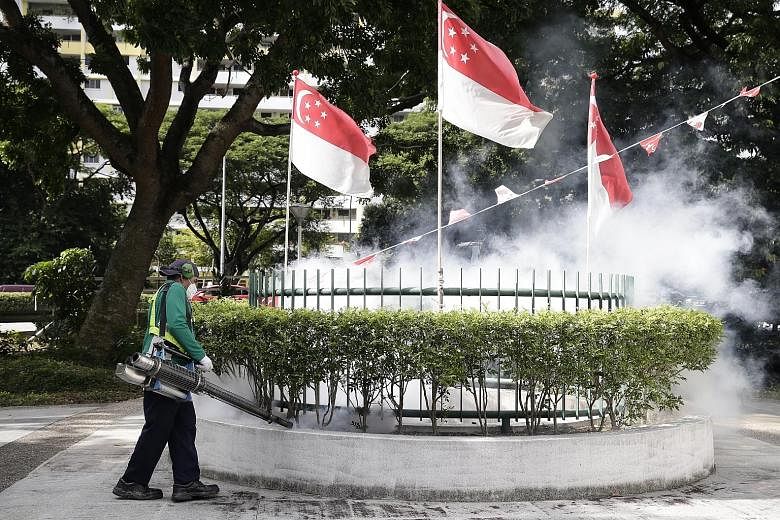The second Raffles Dialogue, hosted last week by the National University of Singapore schools of medicine, public health and public policy along with the National University Health System (NUHS), focused on "The Critical Role of Innovation" in the context of the broader theme of "Human Well-being and Security in 2030".
It was attended by more than 100 global health experts and international participants.
In his opening address looking forward to 2030, Professor John Wong, chief executive of NUHS, urged the audience to consider Charles Darwin's theory of natural selection, published in the mid-1800s, which emphasised that neither intelligence nor physical strength was the critical factor for survival.
Instead, the key to survival is the ability to adapt to change. More than 200 years later, this need to adapt is more pressing than ever.
The dialogue explored innovations in health, information and big data, financing and global governance. In the face of fast-paced change, how will all this innovation weave together? How can societies ensure that the innovations are harnessed for positive disruptions, and not negative ones? How can these innovations help to advance equity, rather than drive inequities, with some benefiting more than others?
One lens on the different paths which innovation can take is focused on vaccines. Vaccination is often lauded as one of the great success stories in public health - at least for those who have access to the vaccines and those who trust and accept them.
H1N1 influenza vaccine uptake rates during the 2009 pandemic, for instance, although higher in Singapore than some other countries, were far from ideal. Recent research has documented routine influenza vaccine rates in Singapore at only 15 per cent among older adults for whom the vaccine is specifically recommended. Other groups considered high-risk, such as children under five years of age and healthcare workers, have also had sub-optimal uptakes.
-
About the writers

Dr Heidi J. Larson is an anthropologist and director of The Vaccine Confidence Project (VCP); professor at the Department of Infectious Disease Epidemiology, London School of Hygiene & Tropical Medicine; clinical professor at the Institute of Health Metrics & Evaluation, University of Washington; and a fellow at the Chatham House Centre on Global Health Security.Dr Larson's research focuses on the analysis of social and political factors that can affect uptake of health interventions and influence policies. Her particular interest is in risk and rumour management from clinical trials to delivery - and building public trust. She served on the United States Food and Drug Administration Medical Countermeasure Emergency Communication Expert Working Group, and is principal investigator of the European Union-funded project on the deployment, acceptance and compliance of an Ebola vaccine trial in Sierra Leone. Dr Larson previously headed Unicef's Global Immunisation Communication. The VCP has developed multiple metrics to measure population confidence in vaccines, from a survey-based Vaccine Confidence Index to temporal analysis of media and social media, and qualitative research to understand the drivers of vaccine reluctance and refusal. The research also includes tracking transnational influences on public trust in vaccines.

Dr Neisha Sundaram is a research fellow at The Vaccine Confidence Project and the Department of Infectious Disease Epidemiology, London School of Hygiene & Tropical Medicine; and a visiting research fellow at the Saw Swee Hock School of Public Health, National University of Singapore.
Dr Sundaram's research interests lie in the prevention and control of infectious diseases, with a focus on vaccine confidence and acceptance. Her research portfolio includes a study of human papillomavirus (HPV) vaccine implementation in South-east Asia and global mapping of HPV vaccine confidence. Her research has focused on identifying individual and institutional determinants of influenza vaccination among healthcare workers in Singapore, evaluating tuberculosis control in Cambodia, pandemic influenza vaccine acceptance and influenza control in western India, and sociocultural determinants of oral cholera vaccine acceptance in Kenya, Zanzibar and the Democratic Republic of Congo. She has a growing interest in behavioural economics and economic evaluation of vaccines. Her training is in epidemiology .
In order to fully realise the potential of the influenza vaccine - a life- saving innovation, people need to be willing to take it.
As a major travel hub, Singapore is vulnerable to emerging infectious diseases. Its rapid and exemplary response to disease outbreaks such as the 2003 Sars epidemic and the more recent Zika outbreak sets it apart as a model of efficiency in the region. The Republic has the potential to lead the way in its proactive approach by paying attention to vaccine confidence, hesitancy and uptake.
Vaccines have saved millions of lives over the past decades, with more vaccines and combinations of vaccines in the pipeline. As the science around vaccines continues to unfold, and there are continuing innovations in the administration and delivery of vaccines, innovations in modes of communication - especially social media - have been an asset and a hazard to their success.
On the one hand, digital media offers new modes of reminding parents when it is time to vaccinate their child, and encourages adolescents and adults to seek the growing number of vaccines available for different stages of life.
On the other hand, there have been highly organised social media campaigns that have spread misinformation about vaccines, creating public anxiety and distrust. The World Economic Forum's 2013 Global Risk Report terms the use of innovative new digital media in these ways as creating "digital wildfires" rather than digital solutions.
All of these new innovations build on existing knowledge, beliefs, trust and distrust and can bring out positive change or amplify negative sentiment, risking or strengthening human well-being and security.
As we get close to 2018, and mark 100 years since the Spanish flu pandemic which killed more people than World War I did, let us not let more people succumb to infectious diseases while hesitating to adopt available life-saving innovations. It is, after all, the ability to adapt - and adopt innovation - that is the key to survival and the future of well-being and human security.

